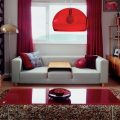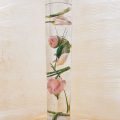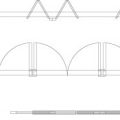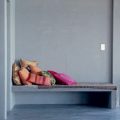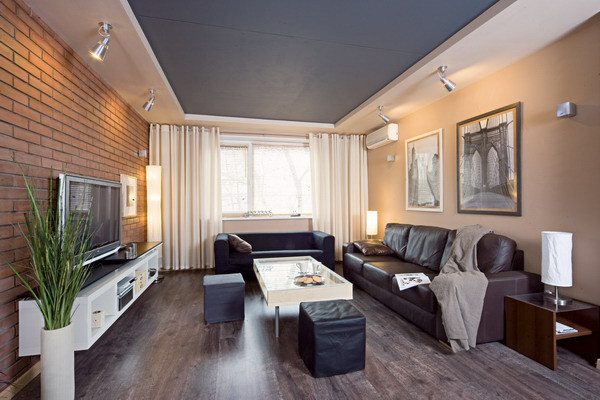 Economy apartment interiorLayout solution
Economy apartment interiorLayout solution The apartment the architect worked onKonstantin Nezhurin, is located in an ordinary nine-story block building. The owners were mostly satisfied with the layout. They only wanted to add loggias, get rid of extra corridors that were eating up useful space, and equip comfortable bathrooms. First of all, by removing the partition between the living room and the kitchen, they got rid of the long narrow corridor that stretched from the hallway to the bathroom, and organized a spacious recreation area. Then they dismantled the lightweight structure of the built-in cabinet near the bedroom and equipped a walk-through dressing room. In the bathrooms, they changed the arrangement of plumbing, and made the block of cramped combined bathrooms a single, more spacious and comfortable one. All new partitions were erected from brick. Some of them were painted the same color as the rest of the walls, while others retained their natural look. The interior of this Moscow apartment is experimental. We worked especially hard on the financial side of the issue — estimates and bills. The owners wanted their apartment to be inexpensive, but cozy and stylish. The architect decided to achieve this by all possible means. They started with materials. They chose the most affordable ones, but not at the expense of quality. Partitions were built from brick. Laminate was laid on the floor. The ceilings were made of plasterboard. The main finishing material in the hallway, kitchen and bathrooms is porcelain stoneware. "When choosing tiles, we focused on the middle price category, and in it on the lowest threshold," the architect says. That is, our porcelain stoneware is a healthy "average" in price, but it is the cheapest among the "average" tiles. In addition, there are many corners in the hallway, kitchen and bathrooms, and it was necessary to think of successful transitions from one surface to another. Unglazed porcelain stoneware, painted in bulk, coped with this best. As the architect explained, it can be overlapped for finishing external corners. In this case, the end of one of the tiles, matching the color of the surface, will be visible. As a result, it is possible to avoid complex operations on cutting corners, using inserted corners and other tricks. The choice of porcelain stoneware for finishing a number of rooms is also due to the fact that they wanted to maintain a single style, which required uniformity of texture and color of the material.
The apartment the architect worked onKonstantin Nezhurin, is located in an ordinary nine-story block building. The owners were mostly satisfied with the layout. They only wanted to add loggias, get rid of extra corridors that were eating up useful space, and equip comfortable bathrooms. First of all, by removing the partition between the living room and the kitchen, they got rid of the long narrow corridor that stretched from the hallway to the bathroom, and organized a spacious recreation area. Then they dismantled the lightweight structure of the built-in cabinet near the bedroom and equipped a walk-through dressing room. In the bathrooms, they changed the arrangement of plumbing, and made the block of cramped combined bathrooms a single, more spacious and comfortable one. All new partitions were erected from brick. Some of them were painted the same color as the rest of the walls, while others retained their natural look. The interior of this Moscow apartment is experimental. We worked especially hard on the financial side of the issue — estimates and bills. The owners wanted their apartment to be inexpensive, but cozy and stylish. The architect decided to achieve this by all possible means. They started with materials. They chose the most affordable ones, but not at the expense of quality. Partitions were built from brick. Laminate was laid on the floor. The ceilings were made of plasterboard. The main finishing material in the hallway, kitchen and bathrooms is porcelain stoneware. "When choosing tiles, we focused on the middle price category, and in it on the lowest threshold," the architect says. That is, our porcelain stoneware is a healthy "average" in price, but it is the cheapest among the "average" tiles. In addition, there are many corners in the hallway, kitchen and bathrooms, and it was necessary to think of successful transitions from one surface to another. Unglazed porcelain stoneware, painted in bulk, coped with this best. As the architect explained, it can be overlapped for finishing external corners. In this case, the end of one of the tiles, matching the color of the surface, will be visible. As a result, it is possible to avoid complex operations on cutting corners, using inserted corners and other tricks. The choice of porcelain stoneware for finishing a number of rooms is also due to the fact that they wanted to maintain a single style, which required uniformity of texture and color of the material.

Making Money with Desserts: Success Stories
Evgeniya Polischuk (Fedutinova) instagram:@evgeniyafedutinovavk.com/janeshomebaking– It all started with baking for family and friends. Gradually, I started posting photos of my baked goods on Instagram – and orders started coming in. I made my first custom-made cake on October 13, 2014, and a little earlier I started making macaroons and cupcakes. You could say that the business “found me”, I am very […]

Soups are cold recipes with photos
Cold cucumber soup with yogurt and lemonsorbet from the chef of the restaurant La Taverna Alexander Zhurkin Photo: Getty Images Ingredients: Plain yoghurt – 125 g Cucumber – 150 g Lemon/lime sorbet – 50 g Cocktail shrimp – 24 g Fresh ginger juice – 1 g Lime juice – 5 g Fresh orange juice – 5 g Parsley – 1 g Pink pepper – 1 g Watercress – […]

barbeque kebab
Pork tenderloin in glaze Photo:Dmitry Bayrak/dbstudioPreparation time: 20 minutes + marinating time.Calories: 454 kcal per serving.For 4 servings: 4 pork tenderloins (approximately 300 g each), 1 onion, 2 cloves of garlic, 1 tsp. lemon zest, 1 tsp. lemon juice, a pinch of ground cumin, coriander and turmeric, 1 tbsp. vegetable […]

Pierre Duacan: dietary recipes: Ducane diet
Beetroot soup Photo:Season’S, Luxury Hotels RepresentationYou will need:· Boiled beetroot – 60 g· Fresh cucumbers – 20 g· Red radish – 20 g· Green onions – 10 g· Egg – 1 pc.· Drinking mineral water – 200 g· Salt – 1 gPreparation:· Boil the egg and beetroot.· Grate the cucumbers, radish and part of the beetroot. Put everything […]
